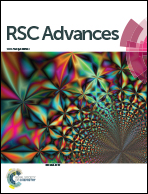Synthesizing highly conductive cobalt sulfide hydrangea macrophylla using long carbon-chain sulfur source for supercapacitors
Abstract
Cobalt sulfide has attracted much attention as the electroactive material for the supercapacitor (SC) because of its high capacitance and cost-effective features. A novel three-dimensional cobalt sulfide hydrangea macrophylla nanostructure with a thin carbon layer growing on the surface has been successfully synthesized by using a simple one-pot method with the addition of 1-dodecanethiol as the sulfur source connected with long carbon chains. The cobalt sulfide hydrangea macrophylla architecture is composed of several two-dimensional (2D) nanopetals intertwined together and thin carbon layers surrounding the nanopetals. A high specific capacitance (CF) of 324.17 F g−1 is obtained for the cobalt sulfide hydrangea macrophylla-based SC electrode measured by cyclic voltammetry (CV) at a scan rate of 10 mV s−1, due to the large surface area for charge accumulation and faradic reactions, as well as the high conductivity for charge transportation respectively benefitting from the 2D nanopetals and the carbon layers. The high CF value achieved in this study opens a window to morphology design for realizing highly effective pseudocapacitors.


 Please wait while we load your content...
Please wait while we load your content...